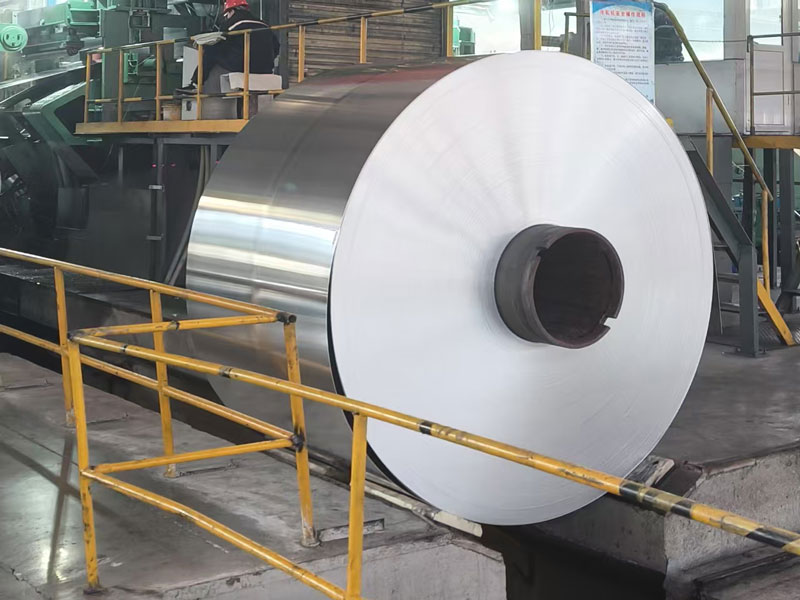
Cold-Rolled Aluminum Plate: The Foundation of Lightweight & Precision Manufacturing
1. Material Characteristics & Production Process
1. Definition & Classification
Cold-rolled aluminum plate refers to aluminum and aluminum alloy sheets produced through cold rolling (rolling temperature below the recrystallization temperature), featuring high precision, high strength, and excellent surface quality.
Alloy Systems:
1-series Pure Aluminum (Al 99.0%~99.9%): Low-cost, corrosion-resistant, used in packaging and architectural decoration;
3-series Al-Mg (e.g., 3003, 3103): Lightweight, tensile strength ≥100 MPa, used in automotive and aerospace;
6-series Al-Mg-Si (e.g., 6061, 6063): High strength (≥270 MPa), heat-treatable强化, used in structural components;
7-series Al-Zn-Mg-Cu (e.g., 7075): Ultra-high strength (≥570 MPa), used in aerospace fasteners.
2. Cold Rolling Process Flow
Melting & Casting:
Alloying melting (Al 95%+ alloying elements) → Vacuum degassing → Pouring into T6-state ingots;
Hot Rolling Slab Preparation:
Ingot heating to 450℃~530℃ → Hot rolling into slabs (thickness 10~30mm);
Cold Rolling:
Multi-pass Rolling: Slab cold-rolled to target thickness (0.1mm~5mm) via 4~20-roll mills with precision ≤±0.01mm;
Tension Control: Applied 0.5%~5 MN/m during rolling to eliminate internal stresses;
Heat Treatment & Straightening:
Solution Treatment (e.g., 6061 alloy: 530℃×30min) → Aging Strengthening (160℃×12h) → Straightening to flatness ≤0.05mm/m;
Surface Treatment:
Anodizing: Film thickness 10~20μm, corrosion resistance enhanced 5×;
Chemical Passivation or Fluorocarbon Coating: Corrosion resistance ≥2,000 hours (GB/T 1771).
2. Core Performance Metrics
Performance Category |
Technical Specifications |
Mechanical Properties |
- Tensile strength: 100~570 MPa (ASTM A370) |
Density |
2.7 g/cm³ (1/3 of steel, 1.3× aluminum) |
Corrosion Resistance |
- Salt spray test: ≥1,500 hours (GB/T 1771) |
Surface Quality |
- Ra ≤0.4μm (mirror finish) |
Electrical Conductivity |
Conductivity ≥63% IACS (pure aluminum: 100% IACS) |
3. Applications & Case Studies
Automotive Lightweighting
Tesla Model 3 Body: Uses 6061-T6 cold-rolled aluminum plate,reducing weight by 10% (vs. steel) and improving collision energy absorption by 20%;
NIO ES8 Battery Pack: Employs 7075-T6 high-strength aluminum plate, achieving torsional rigidity ≥150 kN·m/deg and lifespan ≥10 years.
Aerospace
Airbus A350 Wing Ribs: 7075-T7 aluminum cold-rolled plate with fatigue strength ≥380 MPa (ASTM E466);
Satellite Structural Components: 6061-T6 plate combined with titanium alloy rivets, passing ±150℃ thermal cycling tests.
Architecture & New Energy
Dubai Solar Power Station: 3003-H24 cold-rolled aluminum plates for PV supports, meeting IP65 protection grade;
Shenzhen SEG Plaza Curtain Wall: 6063-T5 aluminum plate reduces self-weight by 40% compared to glass curtain walls.
Precision Electronics
Apple iPhone 15 Pro Case: 7075-T6 cold-rolled aluminum plate + CNC machining, thickness 0.6mm, bending strength ≥350 MPa;
Semiconductor Device Cavity: 6061-T6 plate electrolytically polished to Ra 0.05μm, meeting ISO 1436 sealing standards.
4. Technical Advantages & Market Competitiveness
Lightweight & Energy Efficiency
Automotive sector: 6%~8% fuel efficiency improvement per 10% weight reduction (U.S. Department of Energy data);
Architectural sector: Reduces structural load by 30%~50%, lowering steel usage and CO₂ emissions by ≈1.2 tons/1,000㎡.
High Precision & Functionalization
Conductive Coating: Carbon black/graphene composite layer (surface resistance ≤10⁴ Ω/sq) for EMI shielding;
Antibacterial Coating: Nanosilver particles (0.1wt.%),抑菌率≥99.9% (GB/T 20944.3).
Micro-meter Rolling Accuracy: Achieves strict dimensional tolerances (±0.005mm) for electronic enclosures;
Surface Functionalization:
Sustainability
Recyclability: Aluminum plate recycling rate ≥95%, with recycled aluminum energy consumption仅5% of primary aluminum;
Life Cycle Cost: 60% lower than stainless steel (75% reduction in lifecycle CO₂ emissions, MIT research data).
5. Industry Trends & Challenges
Technology Upgrade Directions
Ultra-Thinning Plates: Developing 0.05mm-grade aluminum sheets for flexible electronics;
Gradient Functional Coatings: Wear-resistant base layer (≥50HRC) + corrosion-resistant top layer (pH 1~13);
AI-Driven Process Optimization: Machine learning models for rolling parameter prediction, improving accuracy by 20%.
Market Growth Drivers
New Energy Vehicles: Global market expected to reach $250 billion by 2030 (Statista), with cold-rolled aluminum demand占比≥40%;
Hydrogen Energy Storage: 6061-T6 plates for cryogenic hydrogen tanks (-253℃ impact resistance, ASTM A370).
Challenges & Solutions
Forming Limit: Breakthrough via hydroforming technology for complex shapes;
Cost Pressure: Utilizing recycled aluminum (≥30% content) to reduce material costs by 15%~20%.
Cold-rolled aluminum plate has become an indispensable material in high-end manufacturing due to its lightweight, high-strength, precision-forming, and long-service-life advantages. With global carbon neutrality goals and the explosive growth of new energy industries, its market size is projected to exceed $400 billion by 2035 (CAGR 9.2%). Future technological advancements will focus on intelligent manufacturing and multi-functional integration, propelling the aluminum processing industry toward high-endization, greenification, and globalization.